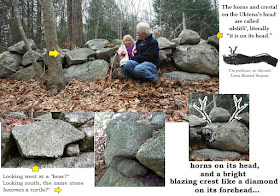Christmas Eve Eve Turtle Snake
and Turtle Bear by a Horned
Serpent, suddenly, with an obvious Ulstitli...
Strong Wind Photography by John A. Martin, Perkasie, Pennsylvania (2017).
“Any thoughts?” my friend John writes on Christmas Eve Eve,
posting some snowy photos of a big stone among smaller stones in Pennsylvania.
I’ve seen this one before, know all sorts of interesting tidbits about it. The
longer stone structure is a “wall” of stone, but it’s like many “walls” here in
Connecticut, a massive petroform effigy snake built by a previously dominant culture,
an Indigenous Great Serpent, a sometimes-protective Spirit Being.
The snow helps highlight a curve of the serpents back, a
subtle hint that this great big stone snake effigy is made of smaller stone snakes,
and I trace a line, add some eyes to John’s photo for effect:
My photo overlay on John's fine photo
“It’s a Turtle!” a few people offer up – and yes, I’m sure
when the sun hits the form just right it is also an obvious turtle, forelegs
and all.
“It’s a Turtlebear Situation,” I’m thinking.
“Just like that
one up in the corner by the road here at home.” Look at it one way and it’s a
turtle (above), but look at it another way (below) and it’s a bear:
(A Zuni Stone Bear Bead:)
"Which is it," I ask my granddaughter, and she shrugs...
The old story here:
A springtime view:
But as I look through my photos I notice that there’s
another big boulder in the mix – and it’s sort of triangular and could be a
snake head – and sure there’s the spot for an eye, so I open up a paint screen
so I can enhance the photo.
I decide that I may as well add some horns while I’m at it
and suddenly there’s the obvious Ulstitli, the jewel on the Uktena’s forehead,
just sitting there all this time and I didn’t notice until just now...
:
(And I removed the terrible photo overlay that was here
and add some newer overlays in October 2022:)



















































